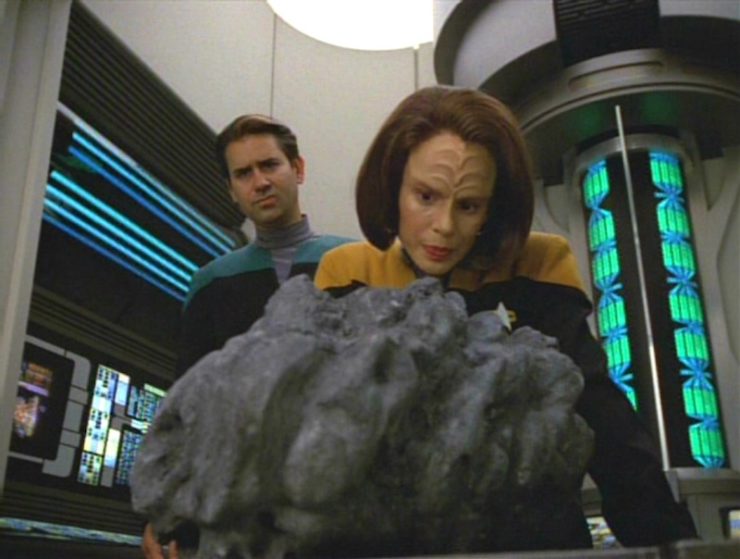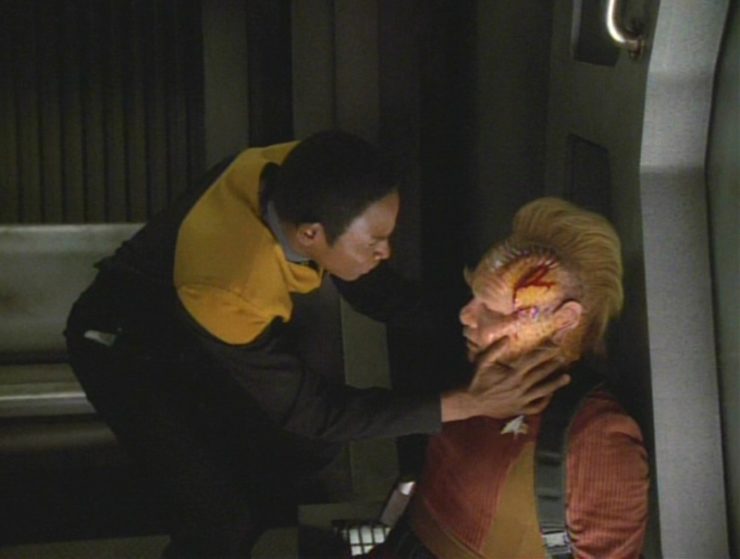“Rise”
Written by Jimmy Diggs and Brannon Braga
Directed by Robert Scheerer
Season 3, Episode 19
Production episode 160
Original air date: February 26, 1997
Stardate: unknown
Captain’s log. Voyager is assisting the Nezu with one of their colonies, which has been bombarded by asteroids for several weeks. Voyager pulverizes one asteroid with their phasers, but it doesn’t disintegrate the asteroid as expected. Hastily, Tuvok fires on more fragments, but two of them make it into the atmosphere.
They strike a deserted area, but there’s another, bigger asteroid en route that will strike a major city. A scientist on the planet, Dr. Vatm, sends a garbled message, indicating that the asteroids may be artificial. The Nezu ambassador is urged by his aide, Sklar, to evacuate the planet, but the ambassador refuses until he hears what Vatm has learned.
Janeway sends three shuttles down to try to find Vatm. Meanwhile, Chakotay has Torres beam an asteroid fragment aboard to examine it.
Buy the Book


Remote Control
Tuvok and Neelix, accompanied by Sklar, go down in one shuttle, which then is forced to crash land thanks to the same atmospheric interference that wiped out Vatm’s communication.
The trio survive the crash without injury, but it will take some time to repair the comm systems enough to signal Voyager. However, they do accomplish their mission, as Vatm is nearby, along with a gallacite miner named Hanjuan, and they saw the crash. Tuvok takes charge and he and Neelix work to assess the damage to the shuttle.
Sklar tries to get Vatm to give his report, but he insists that he can only give it directly to the ambassador.
While inspecting the outer hull for a damage report, Neelix sees a nearby space elevator—an orbital tether that brings a conveyance into orbit on a very large pole.
Vatm says the orbital tether needs repairs, but Neelix says he worked on an orbital tether on Rinax when he was younger. If he can get it operational, they’ll be high enough in the atmosphere to contact Voyager and be beamed aboard, and it’ll be faster than it’ll take to repair the shuttle.
Tuvok agrees, and they hike over. A woman named Lillias is squatting in the conveyance, and threatens Neelix with a knife, but Tuvok and Neelix manage to convince her that they don’t want her stuff, they just want to fix the conveyance. She reluctantly agrees.
Torres and Chakotay examine the fragment with the ambassador observing, and they find a guidance system inside it. These haven’t been natural occurrences—someone is attacking the colony.

Vatm starts the launch sequence prematurely. Tuvok neck-pinches him, but it’s too late—the carriage is launching, but they haven’t completed repairs yet. Neelix has to manually monitor the carriage’s ascent as the magnetic cohesion is lost.
Tuvok—who is already peevish at Neelix for making small talk with Lillias when he should be working—discovers that Neelix exaggerated his experience a touch. He didn’t serve on an orbital tether, he worked with (very detailed!) scale models. It means there are gaps in his practical knowledge.
Unfortunately, their air supply is limited thanks to the incomplete repairs. Lillias and Hanjuan are pissed at Vatm for endangering their lives and they try to throw him out the hatch, but Tuvok talks them down. Tuvok also administers tri-ox to help everyone last longer in the ever-thinning air of the carriage.
Vatm, delirious, tries to open a hatch in order to climb on the carriage roof to retrieve something. But then he goes into shock and dies—and Tuvok’s examination reveals that he was poisoned. Someone put coolant in his water bottle.
Neelix thinks someone should check the roof to see what Vatm was talking about, but Tuvok dismisses Vatm’s words as delusional ravings of a poisoned, oxygen-deprived mind. Neelix insists, and stops the carriage’s upward progress. He’s the only one who can drive the thing, so Tuvok gives in to the inevitable and goes onto the roof himself, as his Vulcan physiology can handle the thinner air better than the others.
He discovers a device hidden in an access port. But then Sklar goes onto the roof. Neelix tries to stop him, and gets knocked on the head for his trouble. Sklar grabs Tuvok’s phaser and tosses him over the side. Sklar then demands that the carriage start up again—but the concussed Neelix is the only one who knows how to pilot it, and he’s in no shape to do so.
Tuvok, however, managed to grab a strut on the way down, because he’s just that awesome, and he clambers over to the hatch, which Neelix sees, and manages to open for him. Fisticuffs ensue, with Sklar being knocked out of the hatch and over the edge to his doom. Neelix manages to pilot the carriage high enough to contact Voyager.
The ship is a bit busy, as it turns out the asteroids were being sent by the Etanian Order, who have now sent ships. Voyager is defending the Nezu, though they do lower shields long enough to beam Tuvok, Neelix, Lillias, and Hanjuan aboard.
Tuvok realizes that the data pad from the roof contains the schematics of the Etanian ship, which they use to do serious damage to their vessels. The Etanians retreat.
Turns out that the Etanians do this sort of thing all the time: send asteroids to make it look like a natural disaster, forcing an evacuation, and then they swoop in to take the world. Voyager’s presence messed with the plan. And it turns out that Sklar was working for them.
In the mess hall, Tuvok thanks Neelix for opening the hatch to let him back into the carriage. He also allows as how Neelix can’t always trust his gut, and he hopes to some day convince him to follow logic, while Neelix hopes to some day convince Tuvok to trust his gut sometimes.
Can’t we just reverse the polarity? It’s never made clear why Voyager’s only option is to fire phasers on the asteroids when they have a perfectly good tractor beam that can deflect the asteroids onto a different course. Or, for that matter, why they don’t destroy the asteroids when they’re much much farther away from the planet…
There’s coffee in that nebula! At one point, the ambassador tries to let Janeway off the hook for helping them, but the captain won’t abandon them under any circumstances, because she’s just that awesome.
Mr. Vulcan. Tuvok handles command mostly okay. Unfortunately, he also has to serve as a de facto field medic, and his bedside manner sucks.
Everybody comes to Neelix’s. Neelix is frustrated by his inability to please Tuvok, and he and the security chief are at loggerheads for the entire episode, partly because of their different approaches to life, but mostly because Neelix overdoes the small talk and lied about his experience.
Please state the nature of the medical emergency. The EMH commiserates with Neelix about how Tuvok doesn’t appreciate either of them.
Do it.
“I am the logical one to make the egress. I can breathe the rarefied atmosphere.”
“I can’t believe you’re going out there—you don’t even know what you’re looking for!”
“I’m looking for Mr. Neelix’s instinct. Perhaps it will be marked.”
–Tuvok being noble, Sklar expressing surprise, and Tuvok bringing the sass.
Welcome aboard. The great Allan Oppenheimer, having previously appeared as Koroth on TNG’s “Rightful Heir” and Captain Keogh on DS9’s “The Jem’Hadar,” plays the ambassador here. Lisa Kaminir plays Lillias with a constant state of anxiety, Kelly Connell plays Sklar with a constant state of neuroses, Tom Towles (last seen as a Klingon on DS9’s “Dramatis Personae“) plays Vatm with a wounded determination, and Geof Prysirr plays Hanjuan with a thuggish affect.
Trivial matters: The notion of a “space elevator” is a common one in science and in science fiction. It was first proposed in 1895 by Konstantin Tsiolkovsky. This is the first time Star Trek has used one. A series of space elevators was also seen in the Starfleet Corps of Engineers novella Ring Around the Sky by Allyn Gibson.
Jimmy Diggs’s story pitch was inspired by the 1965 film The Flight of the Phoenix (which was remade in 2004), down to the bit about a character claiming to be an expert but only having worked on scale models.
This is the last Trek episode directed by the late Robert Scheerer, who directed eleven TNG episodes (starting with “The Measure of a Man,” a pretty auspicious first effort in the franchise), one DS9 episode (“Shadowplay“), and one prior Voyager episode (“State of Flux“).
Neelix names the carriage after his sister, Alixia. He tells Lillias that she died, along with the rest of his family, in a war, as already established in “Jetrel.”

Set a course for home. “You always have to get in the last word, don’t you?” As an episode of Voyager by itself, this is good. It’s got a great science fictional concept in the space elevator (which they call an orbital tether because “space elevator” was likely deemed too pulpy), it’s got good interactions among the characters, a fun little action B-plot, Tuvok being very Vulcan, and Neelix being very Neelix (without being annoying about it).
And if you just look at it by itself out of the context of the rest of Voyager, that’s all good. Hell, if you look at it in the context of all but one episode of the rest of Voyager, that’s all good.
But “Tuvix” is a thing that happened.
The Tuvok-Neelix interactions here make sense if they come during the first or second seasons, but coming after “Tuvix,” it’s nonsensical. The two of them shared a body and mind for two weeks. They should each have a much better understanding of each other at this point, and to have them back to the same rational vs. emotional dynamic they had starting in “Caretaker” is mind-numbingly idiotic. This was a grand opportunity to explore the aftermath of the merging of the two of them in that second-season episode, and instead, they act as if they don’t remotely understand each other, which makes no sense, none, after what they went through.
It’s maddening, because I like that rational vs. emotional dynamic, as it’s played with less verbal abuse than, for example, the similar dynamic between Spock and Leonard McCoy. Tuvok’s calmness is the only thing that keeps everyone alive, as he de-escalates the situation when Lillias and Hanjuan want to toss Vatm out an airlock. Neelix’s gut instinct that they should check the roof after Vatm died was the right one, though his method of going about it was dangerous. (Given how tenuous the ability to pilot the thing was, I can’t imagine that stopping it would make life easier.)
Neelix’s neuroses also have not abated despite Janeway’s reassurances at the end of “Fair Trade” that he’s still a valued part of the crew. He exaggerates his experience to Tuvok in order to prove he’s valuable to the away team, and he wants Tuvok to like him and respect him, neither of which are coins Tuvok is likely to part with, well, ever. Their closing scene is a bit too much of a callback to “Journey to Babel” and McCoy’s glee over getting the last word, but Tim Russ and Ethan Phillips sell it beautifully. Phillips is always better when he’s not being over-the-top goofy, and it’s good to have the Neelix of “Jetrel” and “Fair Trade” who’s an actual complex character.
The guest acting is less impressive. Allen Oppenheimer is utterly wasted in a glorified cameo as the ambassador, while the other Nezu are bland and boring. Between that, and the inability to remember that these two guys shared a brain for two weeks, what should’ve been a strong science fiction story turns into an exercise in frustration.
Warp factor rating: 5
Keith R.A. DeCandido is one of the guests of honor at the virtual Bubonicon 2020 this coming Saturday the 29th of August. Among the events (which can be seen on Zoom, YouTube, or Facebook) will be Keith doing a reading, and participating in panels on writing (with Connie Willis, Walter Jon Williams, Susan Matthews, and Lauren Teffeau) and the use of mythology in fiction (with Teffeau, Rebecca Roanhorse, Reese Hogan, and Chaz Kemp). Keep an eye on the con’s Facebook page for details.










